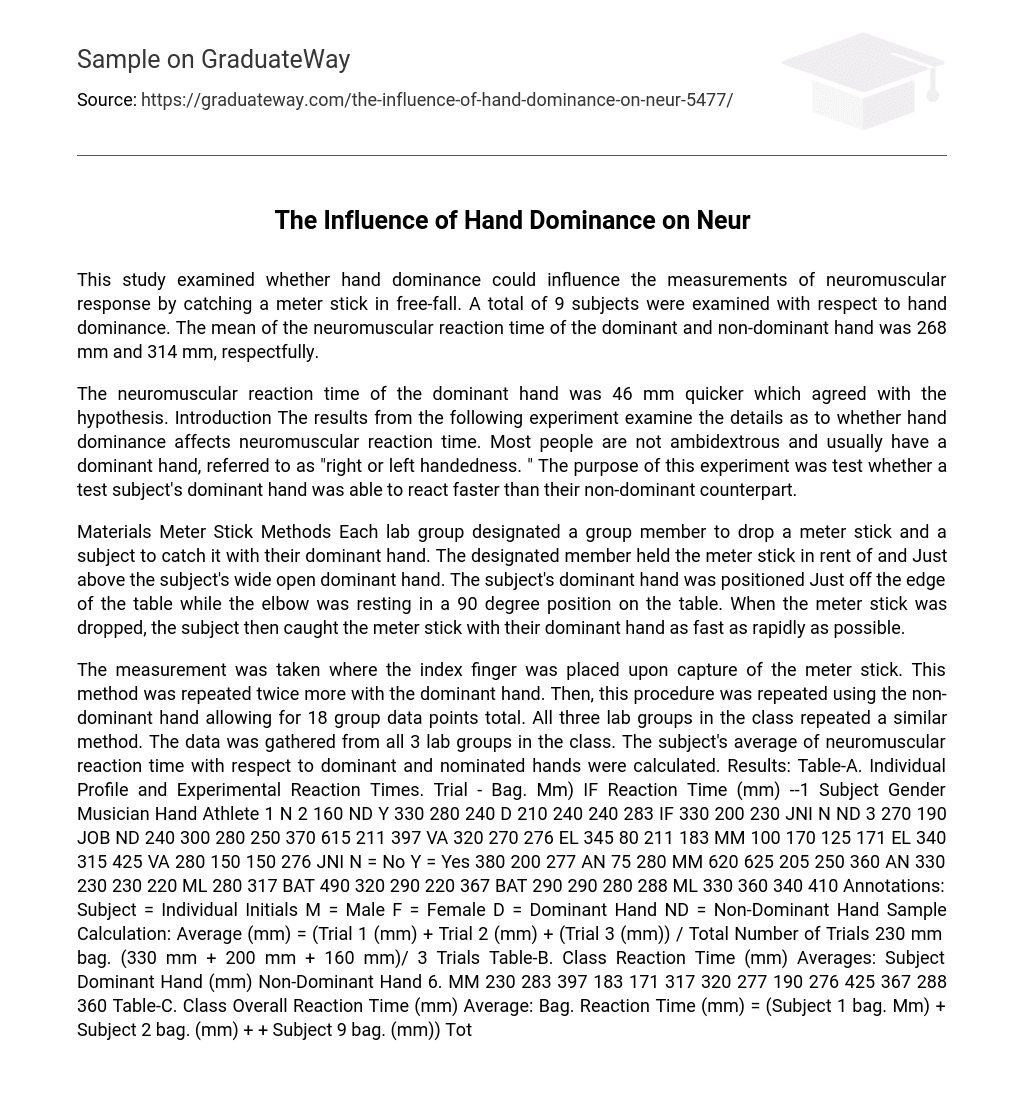The study aimed to examine how hand dominance affects measuring neuromuscular response when catching a meter stick in free-fall. Nine subjects were assessed based on their dominant hand, with an average reaction time of 268 mm recorded for the dominant hand and 314 mm for the non-dominant hand.
The experiment sought to determine if an individual’s dominant hand could react quicker than their non-dominant hand by studying the impact of hand dominance on neuromuscular reaction time. The results confirmed the initial hypothesis, showing that the dominant hand had a reaction time 46 mm faster. It is widely acknowledged that most individuals have a dominant hand, commonly known as right or left-handedness.
Materials: Meter Stick
Methods: Each lab group assigned one member to drop a meter stick and another member to catch it with their dominant hand. The person designated to drop the meter stick held it in front of the subject’s wide open dominant hand, just above it. The subject positioned their dominant hand slightly off the table’s edge, while keeping their elbow at a 90-degree angle on the table. Once dropped, the subject aimed to quickly catch the meter stick with their dominant hand.
During the measurement process, the index finger was placed on the meter stick to capture data. The dominant hand went through this procedure three times, while the non-dominant hand went through it once. This resulted in a total of 18 data points from all subjects. All lab groups in the class followed a similar procedure and collected data. The average neuromuscular reaction time was then calculated for both dominant and non-dominant hands of each subject.
The difference in reaction time between the Non-Dominant Hand and Dominant Hand is determined by subtracting the measurement of Non-Dominant Hand (mm) from the measurement of Dominant Hand (mm), which yields a 46 mm discrepancy (with the dominant hand being faster).
When we refer to “hand-dominance” in our conversation, we are talking about a person’s tendency to favor one hand over the other for activities like writing, playing an instrument, throwing a ball, or catching a falling meter stick as demonstrated in our experiment.
The dominant hand for right-handed people is their right hand, while left-handed individuals have dominance with their left hand. The reasons behind this dominance are still debated, but some studies suggest biological and genetic factors may contribute. However, research has found a connection between the ability to catch a falling meter and neurological pathways involving the eyes, brain, and motor-neurons in the muscles.
The experiment aimed to determine whether a person’s self-declared hand dominance affected their ability to react and catch a falling meter stick. The rate of catching the stick was measured by observing its free-fall length in millimeters (mm). Our findings validated our hypothesis that individuals’ dominant hand would have a quicker reaction time in catching the meter stick compared to their non-dominant hand. These results support the conclusion drawn from our experiment.
The study discovered that the class demonstrated an average reaction time of 268 mm when reacting to and catching the meter stick with their dominant hand (Table-C). On the other hand, when using their non-dominant hand, the class had an average reaction time of 314 mm (Table-C). The discrepancy between these two average reaction times was 46 mm, indicating a preference for using the dominant hand (Table-D). This data confirmed the hypothesis that hand dominance influences neuromuscular responsiveness in catching a falling meter stick. Additionally, other variables were considered in analyzing the test subject profiles.
Additionally, the testing and analysis did not account for several variables such as gender, musician status, and athlete status (Table-A). Including these variables in future testing may yield different results compared to this specific experiment. Therefore, a new hypothesis would need to be formulated and tested. Moreover, there are other significant variables that were not considered in the subject profiles but may impact neuromuscular reaction time. These variables include age, ocular acuity (whether the subject requires restriction awareness), and a history of previous neuromuscular injury or pathology.
For this experiment, the variables not included in the scope are those that require additional information about the subject’s demographics and history. To conduct and analyze the results of the experiment, it is important to have more detailed information by incorporating a comprehensive questionnaire for future experiments exploring the relationship between hand dominance and neuromuscular reaction time. This will provide a better understanding of their background and allow for inclusion of more variables when formulating hypotheses and designing experimental procedures. By including extra demographic and independent variables in future experiments, researchers can obtain a more thorough evaluation of collected data, facilitating comprehensive data analysis.
Further assessments and analysis of data could result in the development of different hypotheses and/or conclusions. The aim of the experiment was to examine the relationship between hand dominance and neuromuscular reaction time. It was speculated that hand dominance might influence neuromuscular reaction time. Following the administration of a meter stick drop test, the gathered data was examined. Mean values were calculated for both individual participants and the whole class, which were then compared.
The experiment revealed a positive correlation between neuromuscular reaction time and hand dominance. In general, participants displayed quicker reaction times when using their dominant hand to grip a meter stick as opposed to their non-dominant hand. The demographic information collected during the experiment was not utilized in the final analysis. Conducting additional tests with diverse demographic data may potentially offer further validation for the findings of the experiment.





